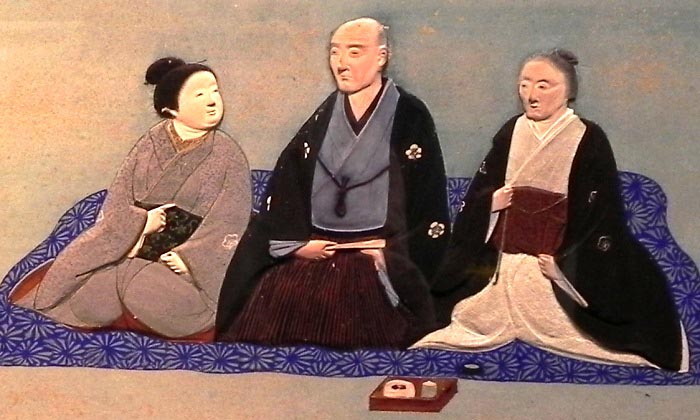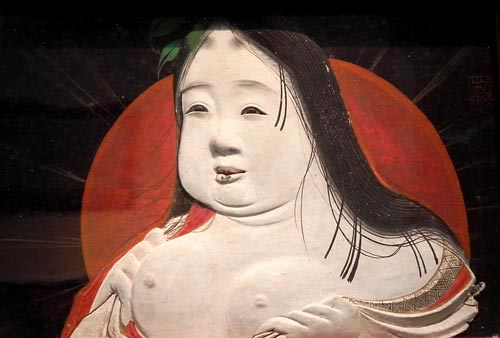- Izu Peninsula top
- General
- Earthquake and volcano
- Too many deer in Izu
- East
- Ito - its old buildings
- Anjin = Wlliam Adams and Ito
- Religious Charisma Nichiren
- Washtub race
- Yokikan - Spa ryokan
- Minami-Kaikisen: Auberge
- Ike and its paddy fields
- Summer has come!!!
- Inatori - fish, spa and more
- Central
- Banjo Waterfall
- Mount Amagi
- Shuzenji - old spa town
- Arabashiri - Bandai-Jozo
- Oomi Land - heart of Izu
- West and south
- Heda on the west coast
- Toi - Gold mine
- Matsuzaki - namako wall
- Izu-no-Chohachi - Plasterer
- Kumomi on the west coast
- Shimoda - Tojin-Okichi
- Cottage life
- Fishing in Usami
- Start of my fishing life
- Training camp in Amagi
- Cottage life / music&drinks
- Party in Izu - part 2
- Party in Izu - part 1
- Sunday morning concert
- Ice and snow in Amagi
- My summer house
- Restaurant and eatery
- Let’s eat Izu-Deer!
- Isui-an - exquisite soba
- Sugizen - big prawn fry
- Sayang - Bali restaurant
- Restaurant Tanaka
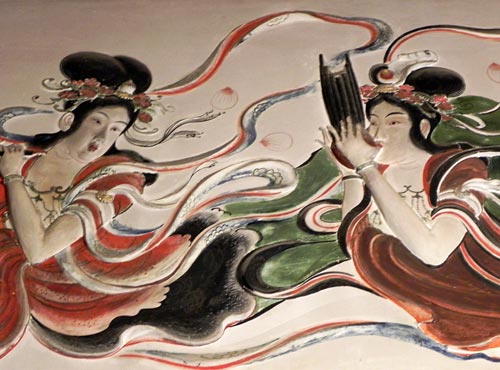
Heavenly nymphs, the earliest colored relief by Chohachi which is preserved to this day. As this picture was taken from the floor, the shape of nymphs are slightly distorted.
Master plasterer Izu-no-Chohachi
 Japan has a long tradition of craftsmanship. It is also our tradition that we do not discriminate against artisans in favor of artists. In other words we do not distinguish between artists and artisans or between art and handcraft. An exemplary genre is ceramics. The people who are evaluated as ceramic artists in the West are in general those who create objects of no practical use, though this might be my prejudice. But, master potters in Japan are evaluated first of all with their tea cups and food plates.
Japan has a long tradition of craftsmanship. It is also our tradition that we do not discriminate against artisans in favor of artists. In other words we do not distinguish between artists and artisans or between art and handcraft. An exemplary genre is ceramics. The people who are evaluated as ceramic artists in the West are in general those who create objects of no practical use, though this might be my prejudice. But, master potters in Japan are evaluated first of all with their tea cups and food plates.We can call up a series of legendary names of master craftsmen. To tell the truth most of them in reality belong to the legendary world and it is difficult to identify real humans with those famous names. An typical case is the famous sculptor Hidari Jingoro, who is thought to have lived at the beginning of the Edo period (1612-1867) and believed to have made the famous "sleeping cat" in Nikko and other sculptures.
Irie Chohachi is also a legendary name as plasterer, sculptor and painter. But, he was a real human being, lived from the end of the Edo period till the 20s of the Meiji period (1868-1912).
Chohachi was born in Matsuzaki on the west coast of Izu Peninsula in 1815 as a son of tenant farmer. He learned elementary reading and calculation at the private school of the nearby Jokanji Temple. He paid his school fee with working at the temple, because his family was too poor to pay the fee. When he became 12, he started to work as apprentice with a plasterer of the village. As the western Izu was a poor region, it was usual that farmers' sons were trained to be carpenter or plasterer so that they could make up the income from farming. Thanks to the large number of well trained plasteres, "namako wall" became popular in Izu.
Chohachi soon showed his talent in the plaster work and when he was 19 he decided to go to Edo (present Tokyo) to work at a master plasterer. Then, a few years later, he went to Kawagoe and became disciple of the renowned painter Busei Kita. In 1838 hearing that his father passed away, Chohachi returned back to Matsuzaki. Then somehow he lost interest to work further and led a vagabond life for several years. Finally, he gave up the unproductive life and resumed his work again with the earlier master plasterer I Edo in 1841.
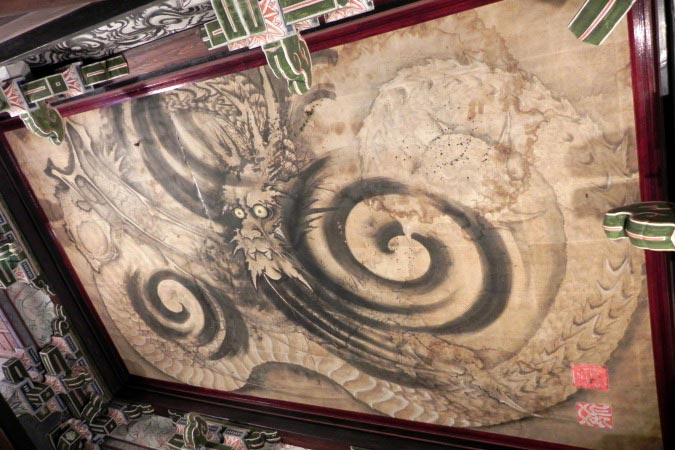
Dragon - painting on the ceiling of the main hall of Jokanji Temple
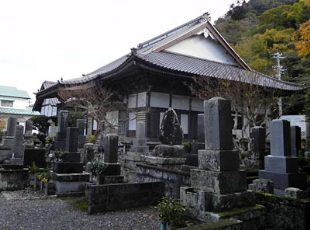
Main hall of Jokanji Temple and its graveyard
Thereafter, he gradually fastened his status in Edo. The change from Edo to Tokyo (1868) did not affect his works. On the contrary he became more active since the late 1870s. He worked not only as plasterer at constructions, but as a sort of artist and started to organize exhibitions of his works in 1876. He was given a prize at the First Domestic Industrial Exhibition in 1877. In 1880 he was again back to Matsuzaki and worked for the Iwashina Shool, including the wall of cranes in the upstairs. After decades of active creation, he died in 1889.

The walls above beams of the guest room of Iwashina School are decorated with 139 cranes. Another walls were plastered also by Chohachi.
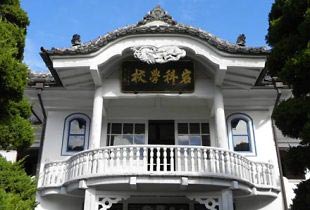
Entrance of Iwashina School
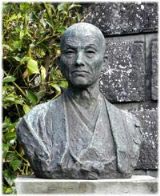 Chohachi |
The plaster work lost its popularity in the 1920s, though some craftsmen in Matsuzaki or else are determined to keep this tradition. In 1984 the Chohachi Museum opened in Matsuzaki with the devoted contribution by the All Japan Plasterer Association. Some 50 works of Chohachi are stored there and regularly displayed for visitors. Further works are seen in Jokanji, where there are also the grave of Chohachi and monuments dedicated to him.
Usually the technique of colored plaster relief is compared with Fresco. I do not know whether this comparison is appropriate. What is sure is that Chohachi developed his technique independent from the European tradition. Nowadays, the merit of handcraft is reevaluated in house construction and I wish that the contemporary plasterers revive the beauty of the Japanese plaster technique developed by Chohachi.
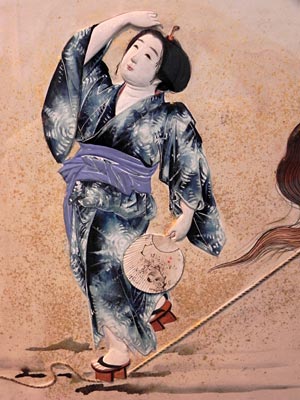
"Okane" (part) is a mighty woman in an old legend.
She could stop a raging horse
just by stepping on its rein.
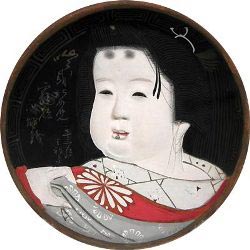
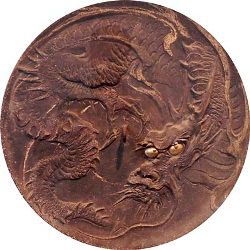
"Okame" (left) is depicted on a clay plate. Okame is the prototype of ugly women. Ugliness was believed to expel evil and became a symbol of happiness.
"Dragon" (right) is a design on the ceiling from where a lamp hangs.
"Dragon" (right) is a design on the ceiling from where a lamp hangs.
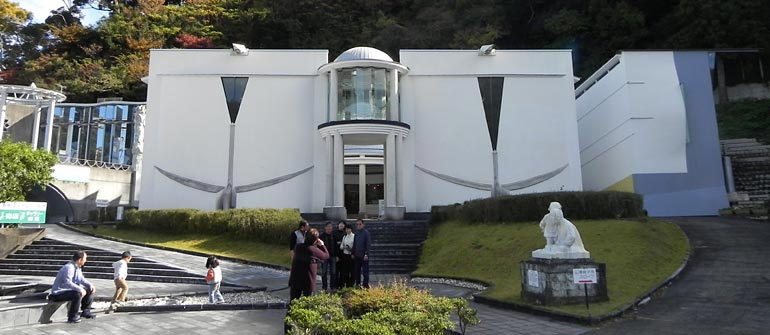
Chohachi Museum is the cristalizaion of devoted contribution by contemporary plasterers and artists conscious of Japan's tradition.
